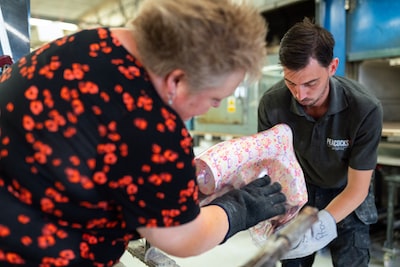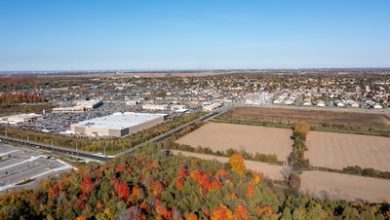
Are you interested in pursuing a career as a drone engineer on LinkedIn? This blog post will provide you with a comprehensive overview of the role, including the education and experience requirements, in-demand skills, and industry trends affecting salaries. We will also explore the factors that determine the average salary range for drone engineers on LinkedIn, as well as the impact of location and specializations within the field. Additionally, we will offer tips on negotiating a higher salary, salary growth opportunities, and benefits and perks offered in this job role. Stay tuned for valuable insights into the world of LinkedIn drone engineering salaries.
Contents
- 1 Overview Of Linkedin Drone Engineer Role
- 2 Factors Determining Linkedin Drone Engineer Salary
- 3 Education And Experience Requirements For Linkedin Drone Engineers
- 4 Average Salary Range For Linkedin Drone Engineers
- 5 Impact Of Location On Linkedin Drone Engineer Salaries
- 6 Specializations Within Linkedin Drone Engineering And Their Salary Differences
- 7 In-Demand Skills For Linkedin Drone Engineers
- 8 Benefits And Perks Offered To Linkedin Drone Engineers
- 9 Industry Trends Affecting Linkedin Drone Engineer Salaries
- 10 Comparison Of Linkedin Drone Engineer Salaries With Other Engineering Roles
- 11 Salary Growth Opportunities For Linkedin Drone Engineers
- 12 Tips To Negotiate A Higher Salary As A Linkedin Drone Engineer
- 13 Frequently Asked Questions
Overview Of Linkedin Drone Engineer Role
The role of a LinkedIn drone engineer is an important and dynamic one within the field of drone technology. These highly skilled professionals are responsible for designing, developing, and maintaining the complex systems that enable drones to operate effectively. A LinkedIn drone engineer combines their expertise in engineering and software development with a deep understanding of drone technology to create innovative solutions for a variety of industries.
One of the key responsibilities of a LinkedIn drone engineer is to develop and implement software algorithms that allow drones to perform specific tasks autonomously. This involves coding, testing, and refining algorithms that enable drones to navigate, avoid obstacles, and complete missions with precision. In addition, drone engineers are also involved in the design and integration of hardware components, such as sensors and cameras, that are necessary for drones to function properly.
A LinkedIn drone engineer also plays a crucial role in ensuring the safety and security of drone operations. They are responsible for developing protocols and safeguards to prevent accidents and unauthorized access to drones. This includes implementing encryption and authentication measures to protect data transmitted between drones and ground control systems. Additionally, drone engineers collaborate with regulatory bodies and industry experts to ensure compliance with safety standards and regulations.
- In summary, a LinkedIn drone engineer is a highly skilled professional who designs, develops, and maintains the systems that enable drones to operate effectively. They work on developing software algorithms, integrating hardware components, and ensuring the safety and security of drone operations. With the rapid growth of the drone industry, the demand for LinkedIn drone engineers is expected to increase, making it an exciting and rewarding career choice.
| Key Responsibilities | Skills | Education |
|---|---|---|
| Develop and implement software algorithms for autonomous drone operations | Software development, coding, algorithm design | Bachelor’s or master’s degree in computer science, engineering, or a related field |
| Design and integrate hardware components necessary for drone functionality | Hardware integration, sensor technology | Bachelor’s or master’s degree in electrical engineering or a related field |
| Ensure safety and security of drone operations | Data encryption, authentication, regulatory compliance | Bachelor’s or master’s degree in aerospace engineering or a related field |
Factors Determining Linkedin Drone Engineer Salary
Factors Determining LinkedIn Drone Engineer Salary
When it comes to determining the salary of a LinkedIn drone engineer, various factors come into play. This blog post will delve into these factors and shed light on how they influence the salary range for professionals in this field.
1. Education and Experience: The level of education and experience a drone engineer possesses can greatly impact their salary. Generally, individuals with advanced degrees such as a master’s or a PhD tend to earn higher salaries compared to those with only a bachelor’s degree. Additionally, professionals with several years of experience in the industry often command a higher pay scale.
2. Specialization: Within the field of LinkedIn drone engineering, there are various specializations that professionals can pursue. These specializations can range from aerial mapping and surveying to drone software development and hardware design. The salary of a drone engineer can vary based on their area of expertise and the demand for that particular specialization in the industry.
3. Location: The geographical location in which a drone engineer works can also impact their salary. Salaries tend to be higher in regions with a high cost of living or areas that have a strong demand for drone engineering services. For example, drone engineers working in metropolitan areas like San Francisco or New York City may earn higher salaries compared to those working in smaller cities or rural areas.
4. In-Demand Skills: The possession of in-demand skills can significantly influence a drone engineer’s salary. Proficiency in programming languages, such as Python or C++, as well as experience in operating advanced drone systems, can make an engineer more marketable and therefore eligible for a higher salary.
5. Industry Trends: The drone industry is rapidly evolving, and trends such as advancements in technology, new regulations, and emerging applications can impact the salary range for drone engineers. Staying up to date with industry trends and acquiring new skills accordingly can present opportunities for salary growth.
Conclusion: The salary of a LinkedIn drone engineer is influenced by various factors including education, experience, specialization, location, in-demand skills, and industry trends. By considering these factors, professionals in this field can have a better understanding of the salary range they can expect and make informed decisions to negotiate a higher salary.
Education And Experience Requirements For Linkedin Drone Engineers
When it comes to pursuing a career as a LinkedIn drone engineer, there are certain education and experience requirements that need to be fulfilled in order to excel in this field. Drone engineering is a relatively new and exciting field, and it requires a combination of technical skills and knowledge in order to be successful. In this blog post, we will discuss the key education and experience requirements for LinkedIn drone engineers.
First and foremost, in terms of education, a bachelor’s degree in engineering or a related field is typically required to become a LinkedIn drone engineer. This degree provides a strong foundation in mathematics, physics, and engineering principles that are essential for designing and building drones. Additionally, courses in computer science and programming can also be beneficial, as they help in understanding the software and control systems used in drone technology.
Furthermore, experience plays a crucial role in becoming a successful LinkedIn drone engineer. Many employers prefer candidates who have practical experience working with drones. This can be gained through internships, co-op programs, or even personal projects. Hands-on experience in operating, troubleshooting, and maintaining drones is highly valued by employers, as it demonstrates practical knowledge and problem-solving skills.
- In addition to formal education and experience, LinkedIn drone engineers should also possess certain key skills. These skills include:
- Technical skills: Proficiency in programming languages such as C++ or Python, as well as knowledge of robotics and automation systems, is essential for drone engineers.
- Problem-solving skills: Drone engineering involves identifying and resolving technical issues, so having strong problem-solving skills is crucial for success in this role.
- Attention to detail: As drones are complex machines, it is important for engineers to pay attention to detail and ensure that all components are working correctly.
In conclusion, pursuing a career as a LinkedIn drone engineer requires a combination of education and experience. A bachelor’s degree in engineering or a related field is typically required, along with hands-on experience with drones. Additionally, possessing technical skills, problem-solving abilities, and attention to detail are key attributes for success in this field. By fulfilling these education and experience requirements, individuals can be well-equipped to embark on a rewarding career as a LinkedIn drone engineer.
Average Salary Range For Linkedin Drone Engineers
When considering a career as a LinkedIn drone engineer, one important factor to consider is the average salary range. As with any profession, the salary of a LinkedIn drone engineer can vary depending on several factors such as experience, location, and specialization.
LinkedIn drone engineers can expect to earn a competitive salary, with the average range falling between $70,000 and $120,000 per year. This range can fluctuate based on the engineer’s level of experience and expertise in the field.
Experience plays a significant role in determining the salary range for LinkedIn drone engineers. Entry-level engineers with minimal experience may start at the lower end of the salary spectrum, while those with several years of experience and advanced skills may command higher salaries. Additionally, LinkedIn drone engineers with specialized knowledge or certifications may have an advantage when negotiating their salary.
Impact Of Location On Linkedin Drone Engineer Salaries
Location plays a significant role in determining the salary of a LinkedIn drone engineer. The pay scale for drone engineers can vary significantly depending on the region, city, or even country in which they work. Different factors come into play when considering the impact of location on drone engineer salaries.
One factor is the cost of living in a particular area. Salaries in cities with a higher cost of living tend to be higher to compensate for the increased expenses. For example, drone engineers working in Silicon Valley or major metropolitan areas like New York City or San Francisco may earn higher salaries compared to those working in smaller towns or rural areas.
Another factor is the demand for drone engineers in a specific location. Areas where there is a high demand for skilled drone engineers may offer higher salaries to attract and retain talent. This can be influenced by factors such as the presence of drone technology companies, research institutions, or government organizations with drone programs.
- Additionally, the regulatory environment of a location can affect salaries. Some countries may have stricter regulations or limitations on drone usage, which could lead to fewer opportunities for drone engineers. In such cases, the salary offered may be lower compared to areas with more favorable drone regulations.
| Location | Average Salary |
|---|---|
| Silicon Valley | $120,000 – $160,000 |
| New York City | $110,000 – $150,000 |
| Austin | $90,000 – $120,000 |
| Denver | $80,000 – $110,000 |
The table above shows the average salaries for drone engineers in different locations. These figures are just estimates and can vary based on factors such as experience, education, and specific company policies.
It is important for drone engineers to consider the impact of location on their salaries when making career decisions. While higher salaries may be offered in certain areas, it is essential to weigh them against other factors such as the cost of living, job opportunities, and personal preferences. Assessing all these elements will help drone engineers make informed choices regarding their careers and future prospects.
Specializations Within Linkedin Drone Engineering And Their Salary Differences
The field of drone engineering has seen tremendous growth in recent years, and LinkedIn has become a hub for professionals in this industry. Within the realm of drone engineering, there are various specializations that individuals can pursue. These specializations not only allow engineers to focus on specific areas of expertise, but they can also influence the salary differences within the field. In this blog post, we will explore the different specializations within LinkedIn drone engineering and how they can impact an engineer’s salary.
1. Aerial Photography and Videography: This specialization focuses on capturing stunning images and videos from the sky using drones. Drone engineers specializing in aerial photography and videography often work closely with photographers and cinematographers to develop advanced camera systems for drones. Due to the demand for high-quality aerial footage, professionals in this specialization have the potential to earn higher salaries than those in other areas of drone engineering.
2. Surveying and Mapping: Drone engineers specializing in surveying and mapping utilize drones to gather topographic data and create accurate maps. They work closely with surveyors and GIS professionals to design and develop drones with advanced mapping capabilities. Considering the importance of accurate geographical information in various industries, such as construction and urban planning, professionals in this specialization can expect competitive salaries.
3. Industrial Inspections: Drones have revolutionized the way inspections are conducted in industries such as infrastructure, energy, and manufacturing. Engineers specializing in industrial inspections develop and operate drones equipped with sensors and cameras to inspect remote or hazardous areas. Given the critical nature of this specialization and the cost-effectiveness of drone inspections, professionals in this field may earn higher salaries compared to other specializations.
4. Delivery and Logistics: As drone delivery systems gain traction, LinkedIn drone engineers specializing in delivery and logistics are in high demand. They work on developing drones capable of delivering packages and goods efficiently and safely. Professionals in this specialization are at the forefront of drone technology, and their expertise and innovation can heavily influence their salary potential.
| Specialization | Average Salary Range |
|---|---|
| Aerial Photography and Videography | $70,000 – $100,000 |
| Surveying and Mapping | $80,000 – $120,000 |
| Industrial Inspections | $90,000 – $140,000 |
| Delivery and Logistics | $100,000 – $160,000 |
Note: The salary ranges provided are approximate and can vary based on factors such as experience, location, and company size.
In conclusion, LinkedIn drone engineering offers a wide range of specializations, each with its own salary differences. Aerial photography and videography, surveying and mapping, industrial inspections, and delivery and logistics are just a few examples of the specializations within this field. It is important for aspiring drone engineers to explore these specializations and consider their own interests and future career goals when choosing a path within the industry. By gaining expertise in a specialized area, professionals can increase their value and, consequently, their earning potential within the exciting field of LinkedIn drone engineering.
In-Demand Skills For Linkedin Drone Engineers
LinkedIn is one of the leading platforms for professionals in various fields, including drone engineering. With the increasing demand for drone technology in industries such as agriculture, photography, and surveillance, the role of LinkedIn drone engineers has become more prominent. However, to excel in this field and stand out among others, LinkedIn drone engineers need to possess certain in-demand skills that are highly valued by employers.
One of the most important skills for LinkedIn drone engineers is proficiency in drone piloting. This involves having a deep understanding of the flight dynamics, controls, and regulations related to operating drones. Strong piloting skills allow engineers to safely and effectively maneuver drones in different environments and situations.
Another crucial skill for LinkedIn drone engineers is data analysis. Drones are equipped with various sensors that collect a vast amount of data during flights. Being able to analyze and interpret this data is essential for extracting valuable insights and making informed decisions. Proficiency in data analysis tools and techniques, such as data visualization and statistical analysis, is highly desirable for drone engineers.
Benefits And Perks Offered To Linkedin Drone Engineers
As a LinkedIn drone engineer, you can expect to enjoy a range of benefits and perks that come with this innovative and exciting role. These benefits and perks are designed to attract and retain top talent in the industry and enhance the overall job satisfaction of drone engineers.
One of the main benefits offered to LinkedIn drone engineers is competitive compensation. The salary for drone engineers can vary based on factors such as experience, education, and location. According to research, the average salary range for drone engineers on LinkedIn is between $80,000 to $120,000 per year, with the potential for higher earnings based on skills and specialization.
In addition to a competitive salary, LinkedIn also offers various perks to drone engineers. These perks may include flexible working hours, remote work options, and generous vacation policies. LinkedIn recognizes the importance of work-life balance and strives to provide its employees with a supportive and flexible work environment.
- Flexible working hours
- Remote work options
| Perks Offered | Description |
|---|---|
| Flexible Working Hours | LinkedIn drone engineers have the flexibility to choose their working hours, allowing them to balance their personal and professional lives effectively. |
| Remote Work Options | Drone engineers at LinkedIn have the opportunity to work remotely, which offers convenience and flexibility in managing their work. |
Industry Trends Affecting Linkedin Drone Engineer Salaries
LinkedIn drone engineers are professionals who design, build, and operate drones for various industries such as agriculture, construction, film production, and surveying. These engineers play a crucial role in shaping the future of drone technology and its applications. Like any other field, the salary of a LinkedIn drone engineer is influenced by various industry trends.
1. Demand for drone engineers: The demand for skilled drone engineers is rapidly increasing as industries recognize the potential of drones in improving efficiency and reducing costs. This high demand for drone engineers creates a competitive job market, leading to higher salaries for qualified professionals.
2. Technological advancements: As technology continues to advance, so does the complexity and capabilities of drones. LinkedIn drone engineers need to stay updated with the latest advancements in drone technology and adapt their skills accordingly. Engineers who possess expertise in cutting-edge technologies tend to command higher salaries due to their specialized knowledge.
3. Regulatory environment: The regulatory environment surrounding drone operations significantly impacts the demand for drone engineers and their salaries. For example, in countries with strict regulations, companies may require highly skilled engineers to ensure compliance, leading to higher salaries. On the other hand, relaxed regulations may result in lower demand and salaries.
4. Industry-specific requirements: Different industries have specific requirements for drone operations. For instance, agriculture may require engineers with knowledge of crop monitoring and analysis, while film production may require expertise in aerial cinematography. LinkedIn drone engineers who specialize in niche industries or possess unique skill sets often command higher salaries due to their specialized expertise.
5. Economic conditions: Economic conditions, such as the financial health of industries that heavily rely on drones, can influence salaries. In times of economic downturn, companies may reduce their drone engineering budgets, leading to lower salaries. Conversely, during periods of economic growth and investment in drone technology, salaries may increase to attract top talent in the field.
Considering these industry trends can provide insights into the factors influencing LinkedIn drone engineer salaries. It is important for professionals in this field to stay informed about the latest trends to make informed career decisions and negotiate competitive salaries.
Comparison Of Linkedin Drone Engineer Salaries With Other Engineering Roles
When it comes to the field of engineering, there are various roles and specializations that professionals can pursue. One such role that has gained significant attention in recent years is that of a drone engineer. With the rapid growth and advancements in drone technology, the demand for skilled professionals has also increased. LinkedIn, being a popular professional networking platform, provides valuable insights into the salaries of different engineering roles, including drone engineers.
Before delving into the salary comparison, let’s briefly discuss what a drone engineer does. A drone engineer is responsible for designing, developing, and maintaining unmanned aerial vehicles (UAVs) or drones. They work on the mechanical, electrical, and software aspects of drones, ensuring their successful operation. The role requires strong technical skills and knowledge in areas such as robotics, control systems, computer vision, and artificial intelligence.
Now, let’s compare the salaries of LinkedIn drone engineers with other engineering roles. It is important to note that salary figures may vary depending on factors such as experience, education, industry, and location. According to LinkedIn data, the average salary of a drone engineer ranges from $70,000 to $130,000 per year. However, it is essential to consider the broader engineering field for a meaningful comparison.
| Engineering Role | Average Salary Range |
|---|---|
| Aerospace Engineer | $80,000 – $160,000 |
| Software Engineer | $90,000 – $150,000 |
| Electrical Engineer | $70,000 – $130,000 |
| Mechanical Engineer | $70,000 – $120,000 |
From the salary comparison table, it is evident that drone engineers fall within a similar salary range as other engineering roles. However, it is important to note that the figures provided are general ranges and can vary depending on individual circumstances. The salaries can be influenced by factors such as industry demand, skill specialization, years of experience, and geographic location.
Considering the rapid growth and potential of the drone industry, it is expected that drone engineers will continue to see promising salary growth opportunities in the coming years. With advancements in technology and increased adoption of drones in various industries, the demand for skilled professionals will likely rise, leading to higher salaries and better career prospects.
Salary Growth Opportunities For Linkedin Drone Engineers
Salary Growth Opportunities For LinkedIn Drone Engineers
LinkedIn drone engineer roles offer immense potential for career growth and attractive salary packages. As the field of drones continues to evolve and expand, there are numerous opportunities for professionals to enhance their skills and progress in their career. This blog post will explore the various avenues through which LinkedIn drone engineers can maximize their salary growth and unlock new possibilities.
Continuous Learning and Upskilling:
One of the key factors determining salary growth for LinkedIn drone engineers is their dedication to continuous learning and upskilling. As technology in the drone industry advances rapidly, professionals must stay updated with the latest trends and acquire new skills. Investing time and effort in obtaining certifications, attending workshops, and participating in training programs can significantly enhance one’s value in the job market. Building expertise in areas such as drone software development, artificial intelligence, or aerial mapping can open doors to higher-paying positions.
Seeking Advanced Roles:
Another way to stimulate salary growth as a LinkedIn drone engineer is by seeking advanced roles within the industry. By demonstrating exceptional technical skills, leadership abilities, and a proven track record, professionals can move up the career ladder and access more lucrative positions. Taking on challenging projects, showcasing problem-solving abilities, and actively seeking leadership opportunities can help individuals position themselves for promotions or higher-paying roles in drone engineering.
Networking and Building Relationships:
Networking plays a significant role in unlocking salary growth opportunities for LinkedIn drone engineers. Building strong professional connections through platforms like LinkedIn, attending industry conferences, and joining relevant associations helps individuals expand their network and open doors to new opportunities. Through these connections, professionals can gain access to potential job openings, collaborations, and partnerships that can contribute to career advancement and increased salary prospects.
| LinkedIn Drone Engineer Salary Range: | USD 75,000 – USD 150,000 per year |
| Average Salary: | USD 100,000 per year |
| Highest Paying Industries: | Defense, Agriculture, Film and Entertainment |
Seeking Employment in High-Paying Industries:
The choice of industry also plays a significant role in salary growth opportunities for LinkedIn drone engineers. Certain industries, such as defense, agriculture, and film and entertainment, tend to offer higher salaries due to the complexity and scale of their drone operations. By targeting job opportunities within these sectors, professionals have a better chance of negotiating higher salaries and benefiting from the industry-specific perks and benefits.
Continual Salary Research and Negotiation:
Lastly, maintaining awareness of industry trends and salary benchmarks is crucial for LinkedIn drone engineers to ensure they are being compensated fairly. Conducting regular salary research, monitoring LinkedIn job postings, and engaging in salary negotiations can lead to better compensation packages. By demonstrating knowledge of the industry standards and their own value as professionals, engineers can negotiate for higher salaries and seize salary growth opportunities.
In conclusion, LinkedIn drone engineers have numerous salary growth opportunities available to them. By investing in continuous learning, seeking advanced roles and responsibilities, networking, targeting high-paying industries, and staying informed about salary trends, professionals can unlock their full earning potential in this exciting field.
Tips To Negotiate A Higher Salary As A Linkedin Drone Engineer
As a drone engineer working on LinkedIn, it is important to not only have the necessary skills and qualifications but also to negotiate a higher salary that reflects your expertise and contribution to the company. Here are some valuable tips to help you negotiate a higher salary as a LinkedIn drone engineer:
1. Research Salary Benchmarks: Before entering into salary negotiations, it is essential to research and understand the industry standards and salary benchmarks for drone engineers on LinkedIn. This will give you an idea of a reasonable salary range based on your skills, experience, and location.
2. Highlight Your Accomplishments: During the negotiation process, it is crucial to showcase your accomplishments and the value you bring to the company. Highlight your successful projects, innovative solutions, and any additional certifications or training you have obtained in the field of drone engineering.
3. Emphasize Your Unique Skills: LinkedIn drone engineers possess unique skills that make them valuable assets to companies. Whether it’s expertise in drone technology, data analysis, or software development, make sure to emphasize your specialized skills and how they contribute to the success of the company.
4. Demonstrate Continued Professional Development: To negotiate a higher salary, it is important to show that you are committed to your professional growth and development. Demonstrate your eagerness to learn and improve by attending relevant workshops, seminars, and conferences. This will showcase your dedication to staying up-to-date with the latest advancements in the field.
5. Showcase Your Network: LinkedIn is a platform built for networking, so leverage your connections to demonstrate the value of your network. Highlight any collaborations or partnerships that have positively impacted your work and discuss how your network can contribute to the success of the company in the future.
6. Be Prepared to Negotiate: Negotiating a higher salary requires confidence and effective communication. Be prepared to discuss your desired salary range and be open to compromise. It is important to convey your worth while remaining respectful and professional throughout the negotiation process.
7. Consider Other Benefits and Perks: While salary is important, don’t forget to consider additional benefits and perks that can enhance your overall compensation package. This may include flexible working hours, professional development opportunities, stock options, or health benefits.
8. Leverage Market Demand: Drone engineering is a rapidly growing field, and companies are constantly in search of skilled professionals. Use this demand to your advantage during salary negotiations, highlighting the market need for your expertise and the positive impact you can make on the company’s success.
9. Be Willing to Walk Away: Sometimes, despite your best efforts, a company may not be able to meet your salary expectations. In such cases, be willing to walk away if the offer does not align with your value and goals. Remember to remain professional and maintain relationships for potential future opportunities.
10. Seek Professional Advice: If you are unsure about the negotiation process or need additional guidance, consider seeking professional advice from career coaches or mentors who are experienced in salary negotiations. They can provide valuable insights and tips specific to the drone engineering industry and LinkedIn.
Frequently Asked Questions
What is the overview of the LinkedIn Drone Engineer role?
The LinkedIn Drone Engineer role involves designing, developing, and operating drones for various purposes such as aerial photography, surveying, or product delivery. They are responsible for ensuring the functionality and safety of the drones.
What are the factors determining LinkedIn Drone Engineer salary?
The factors determining the LinkedIn Drone Engineer salary include experience level, education, location, demand for specialized skills, and the industry or company they work for.
What are the education and experience requirements for LinkedIn Drone Engineers?
LinkedIn Drone Engineers typically require a bachelor’s degree in engineering or a related field. They may also need experience in drone technology, aerodynamics, robotics, or computer programming.
What is the average salary range for LinkedIn Drone Engineers?
The average salary range for LinkedIn Drone Engineers can vary depending on factors such as experience and location. However, a rough estimate suggests that it can range from $70,000 to $120,000 per year.
How does location impact LinkedIn Drone Engineer salaries?
Location can significantly impact LinkedIn Drone Engineer salaries. Major cities or regions with high demand for drone technology may offer higher salaries, while less-developed areas might have lower salary ranges.
What are the specializations within LinkedIn Drone Engineering and their salary differences?
LinkedIn Drone Engineering offers specializations such as aerial photography, agriculture, surveying, or disaster response. Salary differences may exist based on the demand and complexity of these specializations.
What are the in-demand skills for LinkedIn Drone Engineers?
In-demand skills for LinkedIn Drone Engineers include proficiency in drone operation and maintenance, knowledge of aerodynamics and aviation regulations, data analysis, computer programming, and problem-solving abilities.
What benefits and perks are offered to LinkedIn Drone Engineers?
Benefits and perks offered to LinkedIn Drone Engineers may include health insurance, retirement plans, paid time off, professional development opportunities, flexible work hours, and the chance to work on cutting-edge technology.
How do industry trends affect LinkedIn Drone Engineer salaries?
Industry trends such as the increasing applications of drones in various sectors or advancements in drone technology can lead to a higher demand for LinkedIn Drone Engineers, which in turn may positively impact their salaries.
How do LinkedIn Drone Engineer salaries compare to other engineering roles?
LinkedIn Drone Engineer salaries can vary compared to other engineering roles. They may be on par with or slightly higher than salaries for traditional engineering roles, depending on the demand and level of expertise required for drone technology.
What are the salary growth opportunities for LinkedIn Drone Engineers?
Salary growth opportunities for LinkedIn Drone Engineers can arise from gaining more experience, expanding their skill set, or taking on leadership roles within the drone engineering field. Additionally, advancements in drone technology and increased market demand can also contribute to salary growth.
What are some tips to negotiate a higher salary as a LinkedIn Drone Engineer?
To negotiate a higher salary as a LinkedIn Drone Engineer, it is advisable to research industry standards and salary ranges, highlight your relevant experience and skills, demonstrate the value you can bring to the company, and effectively communicate your negotiation points during the job offer or performance review process.




